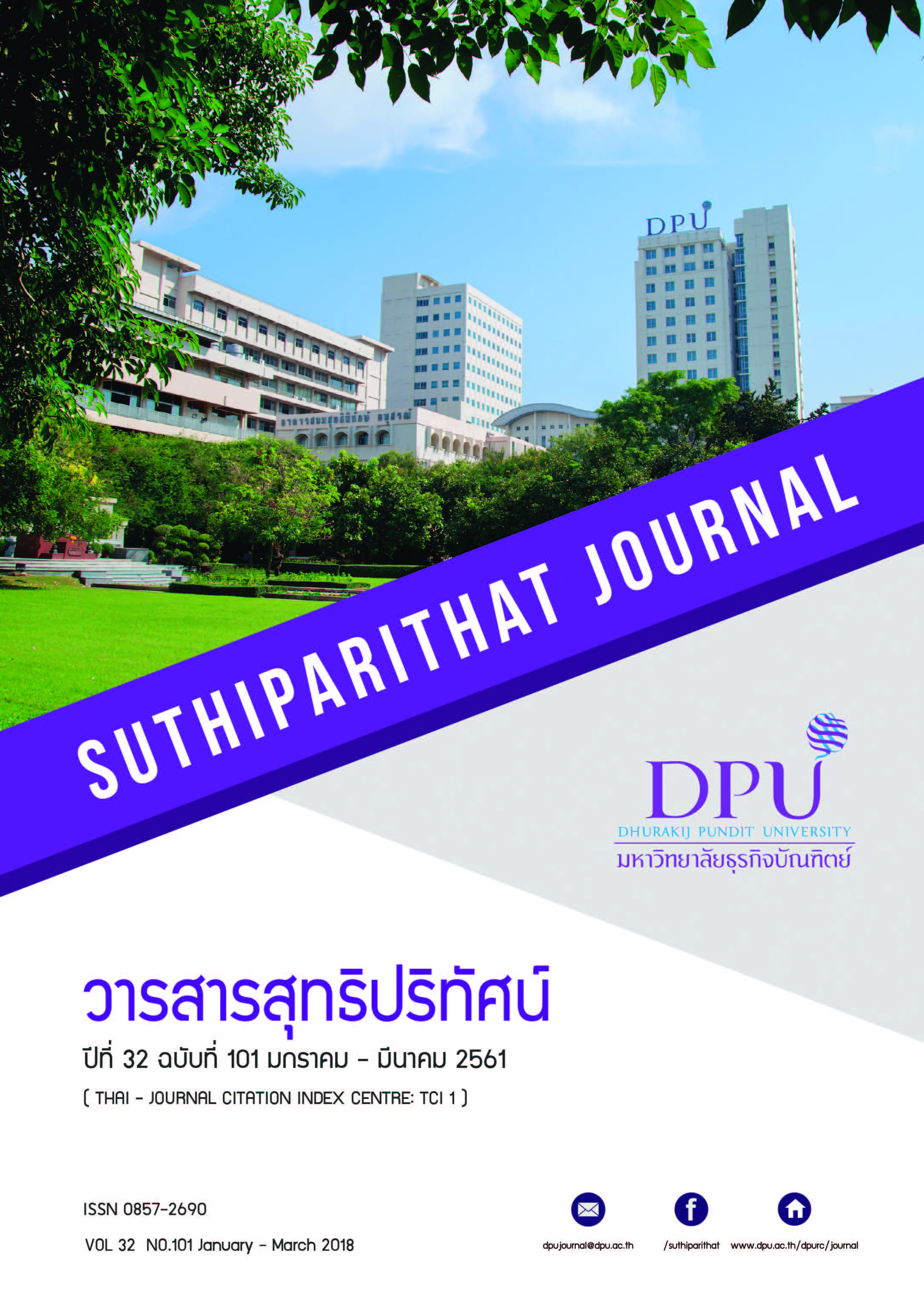มูลค่าองค์กรกับการเปิดเผยข้อมูลตามรูปแบบของรายงานเชิงบูรณาการ
คำสำคัญ:
รายงานเชิงบูรณาการ, ความสัมพันธ์ระหว่างมูลค่าองค์กร, การเปิดเผยข้อมูลบทคัดย่อ
รายงานเชิงบูรณาการเป็นการนำเสนอข้อมูลที่เกี่ยวข้องกับทรัพยากรและความสัมพันธ์ใน การใช้ทรัพยากรที่ส่งผลต่อการสร้างมูลค่าให้กับองค์กรซึ่งในรายงานเชิงบูรณาการประกอบด้วย ข้อมูลทุน องค์ประกอบด้านเนื้อหาสาระและตัวชี้วัด การศึกษานี้จึงมีวัตถุประสงค์เพื่อศึกษาระดับของการเปิดเผย ข้อมูลของรายงานเชิงบูรณาการและศึกษาความสัมพันธ์ระหว่างการเปิดเผยข้อูลตามรูปแบบของรายงาน เชิงบูรณาการกับมูลค่าองค์กรตามราคาตลาดของกลุ่มธนาคารพาณิชย์ในตลาดหลักทรัพย์แห่งประเทศไทย โดยใช้การวิเคราะห์เนื้อหา (Content Analysis) จากรายงานประจำปี ผลจากการศึกษาพบว่า มีการเปิดเผย ข้อมูลย่อยในส่วนของทุนและตัวชี้วัดอยู่ในระดับน้อย ข้อมูลย่อยในส่วนขององค์ประกอบด้านเนื้อหาสาระ พบว่า มีการเปิดเผยข้อมูลทั่วไปขององค์กรและสภาพแวดล้อมภายนอกรูปแบบธุรกิจและผลการดำเนินงาน อยู่ในระดับมาก นอกจากนั้นการเปิดเผยข้อมูลตัวชี้วัดทางสังคมและตัวชี้วัดทางธรรมาภิบาลมีความสัมพันธ์ กับมูลค่าขององค์กรตามราคาตลาดอย่างมีนัยสำคัญ ณ ระดับความเชื่อมั่น 95%
เอกสารอ้างอิง
Abrahamson, E., & Amir, E. (1996). The information content of the president’s letter to shareholders. Journal of Business Finance & Accounting, 23(8), 1157-1182.
Atkins, J., & Maroun, W. (2015). Integrated reporting in South Africa in 2012: Perspectives from South African institutional investors. Meditari Accountancy Research, 23(2), 197-221.
Baboukardos, D., & Rimmel, G. (2016). Value relevance of accounting information under an integrated reporting approach: A research note. Journal of Accounting and Public Policy, 35(4), 437-452.
Barron, A., Birgé, L., & Massart, P. (1999). Risk bounds for model selection via penalization. Probability theory and related fields, 113(3), 301-413.
Bozzolan, S., Favotto, F., & Ricceri, F. (2003). Italian annual intellectual capital disclosure: An empirical analysis. Journal of Intellectual capital, 4(4), 543-558.
Breton, G., & Taffler, R. J. (2001). Accounting information and analyst stock recommendation decisions: a content analysis approach. Accounting and business research, 31(2), 91-101.
Buhr, N. (1998). Environmental performance, legislation and annual report disclosure: the case of acid rain and Falconbridge. Accounting, Auditing & Accountability Journal, 11(2), 163-190.
Burke, J. J., & Clark, C. E. (2016). The business case for integrated reporting: Insights from leading practitioners, regulators, and academics. Business Horizons, 59(3), 273-283.
Clarkson, P. M., Kao, J. L., & Richardson, G. D. (1994). The voluntary inclusion of forecasts in the MD&A section of annual reports. Contemporary accounting research, 11(1), 423-450.
Clayton, A. F., Rogerson, J. M., & Rampedi, I. (2015). Integrated reporting vs. sustainability reporting for corporate responsibility in South Africa. Bulletin of Geography. Socio-economic Series, 29(29), 7-17.
Dufays, L. (2012). Responsible Banking, the 10 Principles. Aestimatio, (5), 238.
Eccles, R. G., & Serafeim, G. (2014). Corporate and integrated reporting: A functional perspective.
Flower, J. (2015). The international integrated reporting council: a story of failure. Critical Perspectives on Accounting, 27, 1-17.
Freeman, R. E., Wicks, A. C., & Parmar, B. (2004). Stakeholder theory and the corporate objective revisited. Organization science, 15(3), 364-369.
Frias-Aceituno, J. V., Rodriguez-Ariza, L., & Garcia-Sanchez, I. M. (2013). The role of the board in the dissemination of integrated corporate social reporting. Corporate Social Responsibility and Environmental Management, 20(4), 219-233.
Guthrie, J., Petty, R., Ferrier, F., & Wells, R. (1999, June). There is no accounting for intellectual capital in Australia: a review of annual reporting practices and the internal measurement of intangibles. In OECD Symposium on Measuring and Reporting of Intellectual Capital (pp. 9-11).
Hackston, D., & Milne, M. J. (1996). Some determinants of social and environmental disclosures in New Zealand companies. Accounting, Auditing & Accountability Journal, 9(1), 77-108.
Krippendorff, K. (2004). Content Analysis: An Introduction to Its Methodology (2nd ed.). California: Sage.
Lee, K. W., & Yeo, G. H. H. (2016). The association between integrated reporting and firm valuation. Review of Quantitative Finance and Accounting, 47(4), 1221-1250.
ดาวน์โหลด
เผยแพร่แล้ว
รูปแบบการอ้างอิง
ฉบับ
ประเภทบทความ
สัญญาอนุญาต
เนื้อหาและข้อมูลในบทความที่ลงตีพิมพ์ในวารสารสุทธิปริทัศน์ ถือเป็นข้อคิดเห็นและความรับผิดชอบของผู้เขียนบทความโดยตรงซึ่งกองบรรณาธิการวารสาร ไม่จำเป็นต้องเห็นด้วย หรือร่วมรับผิดชอบใด ๆ
บทความ ข้อมูล เนื้อหา รูปภาพ ฯลฯ ที่ได้รับการตีพิมพ์ในวารสารสุทธิปริทัศน์ ถือเป็นลิขสิทธิ์ของวารสารสุทธิปริทัศน์หากบุคคลหรือหน่วยงานใดต้องการนำทั้งหมดหรือส่วนหนึ่งส่วนใดไปเผยแพร่ต่อหรือเพื่อกระทำการใด ๆ จะต้องได้รับอนุญาตเป็นลายลักษณ์อักษรจากวารสารสุทธิปริทัศน์ก่อนเท่านั้น







